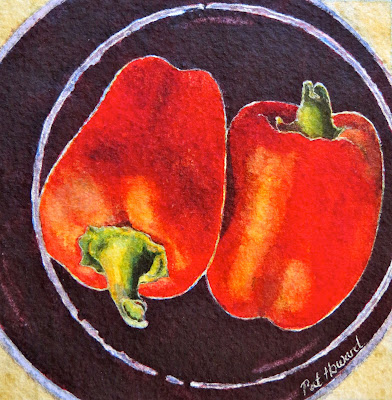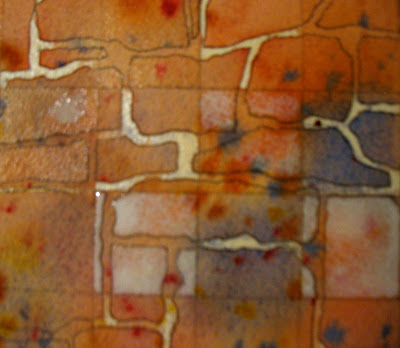Try a few, or all, of these exercises, and you'll be "seeing red" -- in a good way, I hope.
For the first 5 RED exercises, you'll need your sketchbook, a pencil, a black pen, some watercolor pencils or colored pencils, some w/c paints, some magazines (you know you have some old ones lying around), a glue stick or "Yes" paste, and scissors.
1) Draw a part of a red motorcycle, bicycle, tricycle, or wagon -- Draw a contour line drawing, with a black pen. Don't worry about proportions, or whether you've drawn it correctly. This is your sketchbook -- it doesn't have to be perfect. "Perfect" is boring, anyway, don't you think? Then, add some color, with a little red watercolor. Add some shadows with cross-hatching in pen and a simple gray wash (or touch the edge of the black pen line with water to make a gray wash) . . .
2) Draw a single flower, right in the middle of your page -- Draw with black pen -- then, add color with colored pencils and watercolor pencils. Layer these colors -- starting with yellow first; then, add the reds. Finish with some darks in purple. . .
3) Draw some red apples still on the tree -- First, draw 2 or 3 skinny rectangles on a page, and within that format, draw some apples on a branch, with a few leaves. Draw this in pencil first. Then color the apples red, the branch brown, and the leaves green. Now, fill in the background with a gold. You can use watercolor pencils, so you can use a wet brush over the pencil. This is helpful for covering large areas, like the background. When this is dry, go over all the lines, including the rectangle, with a black pen. . .
Design these rectangles, so the apples and leaves are cropped, making interesting negative shapes.
4) Draw the insides of your pantry -- Collect all the bottles/jars/containers from your cupboard or pantry, that contain the color red (not on the inside, but outside). Arrange them on a shelf or two. Draw a contour line drawing with a black pen, adding some cross-hatching. Then, add a little color, with paint or colored pencils. Add a few other colors, besides red, for contrast. . .
(Now, put everything back the way it was . . . or not.)
5) Make 2 color collages -- Gather some old magazines, and tear out some examples of red. After you have a big pile of all shades and values of red, cut them into strips. . .
Now, make three piles of these: one pile of DARK REDS, one pile of MID-TONE REDS (this will be your brightest pile), and one pile of LIGHT REDS (pinks).
From the middle pile of MID-TONE REDS, arrange them from red-violet to cool red to warm red to red-orange. (The process is more important than the end result -- this is not an exact science). Now, glue this down on a page of your sketchbook.
Now, using some strips from each of the piles, make an arrangement where you go from darkest dark to lightest light, and glue those down.
This is a good exercise to train your eye to see temperature changes within a color family, and to see value changes within the same color family.
--------------------------------------------------------------------------------------------------
For these next 5 color studies, use a watercolor sketchbook, if you have one, or scraps of good watercolor paper, or a pad of cheap watercolor paper, like 90 lb. You'll also need a pencil, and your paints and brushes.
1) Minglings -- On a few small scraps of watercolor paper, do some wet-in-wet minglings, using all the reds on your palette. Wet each paper first, and while it's still wet, drop in the colors. . .
Now, try another mingling -- but, this time, spritz the paper first, with clear water, then spatter on the paint. Use all your red paints again. Spritz it again with water, and then spatter on some other colors.
2) Mosaic Blossom -- Using either a red flower from your garden or home, or a photo of a red flower (one with lots of petals -- like a geranium, or dahlia, or zinnia, or rose -- the more shapes, the better), start painting without drawing. Start in the middle, and paint the first little shape. Then, move out from there, painting each shape you see, one at a time. Leave a tiny white space between the shapes, so you don't have to wait for one shape to dry, before painting the one right next to it. Vary your reds with each shape. . .
3) Red Peppers -- Draw and paint 1, 2, or 3 peppers, using both warm and cool reds within the pepper. Leave some white highlights, and be sure to paint the green stem, for contrast. Arrange your peppers on a patterned tablecloth, a white sheet of paper, or in a black bowl . . .
4) Imaginary Bouquets (no drawing allowed) -- Paint these bouquets very quickly and very small, so you won't worry about details. The first one, paint a few red tulip shapes, a blue flower shape, and a few green shapes to indicate some stems and leaves. Paint it onto dry paper.
In the 2nd little painting, paint the shape of a bouquet with clear water, and then drop in red for the flowers, and some yellow and blue for the leaves. When that is dry, paint a red pot. . .
5) Close-up of a Red Flower -- Either looking at a real flower, or at a photo of one, draw it in pencil first. Then, paint it, petal by petal, wetting it with clear water first and then using both cool and warm reds in the petals.































































